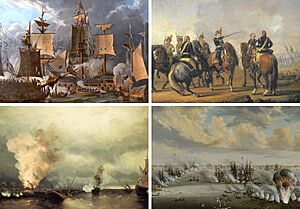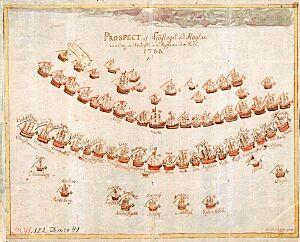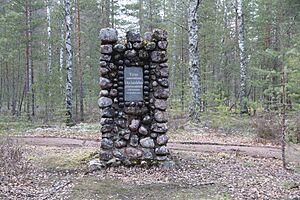Russo-Swedish War (1788–1790) facts for kids
Quick facts for kids Russo-Swedish War of 1788–1790 |
|||||||||
|---|---|---|---|---|---|---|---|---|---|
| Part of Russo-Swedish Wars | |||||||||
 From left to right:
|
|||||||||
|
|||||||||
| Belligerents | |||||||||
|
|||||||||
| Commanders and leaders | |||||||||
|
|
||||||||
| Strength | |||||||||
| 23,000 - 38,720 | 38,000 | ||||||||
| Casualties and losses | |||||||||
| 2,640 killed or wounded 6,000 captured |
3,000 killed or wounded 4,500 captured |
||||||||
The Russo-Swedish War of 1788–1790 was a conflict between Sweden and Russia. It lasted from June 1788 to August 1790. This war ended with the Treaty of Värälä on August 14, 1790. It happened at the same time as other major wars, like the Austro-Turkish War (1788–1791) and the Russo-Turkish War (1787–1792). Overall, this war did not change much for either side.
King Gustav III of Sweden started this war for reasons back home. He hoped it would make people support him more. Even though Sweden made an alliance with the Ottoman Empire, they could not get help from Great Britain, the Dutch Republic, or Prussia. Sweden's first plan was to attack Saint Petersburg and try to remove Empress Catherine II from power. This plan did not work out.
The war also led to Denmark–Norway declaring war on Sweden. However, peace was signed between them on July 9, 1789. This happened after Great Britain and Prussia stepped in to help. During the war, both Swedish and Russian navies fought several battles. These included the Battle of Öland and the First and Second Battle of Svensksund. The Second Battle of Svensksund was Sweden's biggest naval win. The Battle of Reval was Russia's biggest success at sea. On land, there were many small fights, but neither side gained much.
King Gustav III realized it was hard to defeat Russia. Also, the war was costing Sweden a lot of money. Empress Catherine II of Russia was busy with other conflicts. So, both leaders wanted peace. In the end, the war did not solve their problems at home.
Contents
Why the War Started: The Background
This war began because of King Gustav III of Sweden. He thought a short war would make people in Sweden support him. In 1772, he had taken full power in a peaceful takeover. But he did not have the right to start a war without his parliament's approval.
The King was becoming less popular, especially after 1786. Russia even encouraged people who opposed him. Gustav III noticed this Russian support for his enemies. This made him think war was unavoidable. Other European powers, like Great Britain and Prussia, were worried about Russia's wins against the Ottoman Empire. They wanted a war in the north to distract Russia's Empress Catherine II.
Because of this, Gustav III made an alliance with the Ottoman Empire in 1788. But Great Britain, the Dutch Republic, and Prussia did not want to join Sweden. Only the Ottoman Empire agreed to be Sweden's ally.
Getting Ready for War: Plans and Problems
Sweden first planned a sea attack on Saint Petersburg, Russia's capital. One Swedish army would march through Finland. Another army, with small ships, would move along the Finnish coast. A third army would sail with the main Swedish navy to land near Saint Petersburg. The goal was to cause a sudden change in power in Russia and remove Empress Catherine II. Sveaborg was chosen as the main base for this plan.
This whole plan depended on the Swedish navy winning a big victory at sea. Russia was not completely unprepared for war. Most of their Baltic Fleet was getting ready to fight the Ottoman Empire.
The war was not popular, especially in the eastern part of Sweden (Finland). Even high-ranking military leaders did not want to go to war. Many army officers were unhappy. Some still supported ideas for Finnish independence.
In 1788, a tailor was asked to make Russian military uniforms. These uniforms were later used in a fake attack at Puumala, a Swedish outpost. This happened on June 27, 1788. This staged attack made people in Stockholm angry. It gave King Gustav III an excuse to declare a "defensive war" on Russia. This was important because the King could not start an offensive war without his parliament's permission. And they had already said no.
The War Years: Key Events
1788: Early Battles and Danish Involvement
The Swedish main fleet sailed from Karlskrona on June 9, 1788. Duke Charles of Södermanland was its commander. On July 7, the fleet learned that war with Russia had begun. The next day, they captured two unprepared Russian ships.
The Swedish fleet then met a Russian fleet led by Admiral Samuel Greig. They fought the Battle of Hogland. Neither side won a clear victory. When the Swedish fleet returned to Sveaborg for repairs, they found it lacked supplies for large warships.
The Swedish coastal fleet left for Finland on June 25. It carried over 9,000 soldiers. They reached Sveaborg on July 2. On July 26, the coastal fleet sailed towards Frederikshamn with 6,000 men. Another 4,000 men marched on land. The Swedish coastal fleet had a small fight with Russian ships on July 28.
Swedish attempts to land troops near Frederikshamn began on August 2. Bad weather stopped the main force. A Russian counterattack forced the Swedish landing party to go back to their ships. Landings were successful on August 3, but Russian resistance stopped the Swedish advance. The quick capture of Frederikshamn failed. This was partly because officers were becoming more unhappy with the King.
On August 9, a group of officers asked for peace with Russia. On August 12, they signed the Anjala declaration, which became known as the Anjala conspiracy. King Gustav III's situation improved when news arrived that Denmark–Norway might declare war. He could return to Sweden on August 25 without being seen as abandoning his troops.
Denmark–Norway declared war on Sweden in August, as they had a treaty with Russia. A Norwegian army briefly entered Sweden. They won the Battle of Kvistrum Bridge. But peace was signed on July 9, 1789, after Great Britain and Prussia stepped in. Denmark–Norway then became neutral, ending the Theatre War.
The Russian fleet blocked the Swedish fleet in Sveaborg in early August. A small Russian group cut off the safe sea route near Hangö in late August 1788. This caused big supply problems for the Swedish forces. On October 17, the Swedes managed to fight off the Russians long enough for small ships to get past the blockade. This likely saved important supplies. A few days later, the Russians left their position.
Since Sveaborg could not repair the large ships, the Swedish fleet had to sail to Karlskrona. They left on November 20, even though the sea at Sveaborg was already frozen. The fleet reached Karlskrona a week later, just before that port also froze.
To stop Russian ships from blocking coastal routes, Sweden built forts at Hangö and nearby islands during the winter of 1788-1789. More forts were built near Korpo. But Porkala cape was left unprotected. Most of the Swedish army in Finland, about 13,000 men, was stationed at the Kymmene river. Another 5,000 men were in Savolax. The troops still needed supplies, but their discipline was much better than in 1788.
At sea, Sweden faced problems. Many sailors in Karlskrona were sick with fever. This made it hard to prepare ships. The fleet could not sail until July 6, under Duke Charles of Södermanland.

The Russian fleet sailed in mid-May. On May 22, some Russian ships checked Swedish defenses at Hangö. The main Russian fleet met the Swedish fleet on July 26. They fought the Battle of Öland. Like the year before, the battle was not decisive. The Swedes went to Karlskrona, and the Russian fleet joined another Russian group. A widespread sickness then kept the Swedish fleet in Karlskrona for most of the year.
The Swedish coastal fleet had to be prepared in Finland. Its commander, Colonel Anckarsvärd, was arrested for being part of the Anjala conspiracy. Admiral Carl August Ehrensvärd replaced him. The Swedish coastal fleet sailed from Sveaborg in late May. But the Russians blocked the coastal route at Porkala on June 10. This split the Swedish coastal fleet, making it harder for them to get help.
In mid-June 1789, the Russians attacked Savolax from three directions. They had about 10,000 men against 4,000 Swedish defenders. Despite winning the Battle of Porrassalmi, the Swedish army had to retreat. King Gustav III took control of the main Swedish army. He started an attack towards Villmanstrand on June 25. The Swedes won at Utti on June 28. But instead of going to Villmanstrand, the King went to Frederikshamn. The Swedish attack got stuck again.
The Russian coastal fleet began attacking the Swedish coastal fleet on August 15. This led to the first Battle of Svensksund. The Russians tried to use their win to launch a combined attack with their army. This pushed the remaining Swedes beyond the Kymmene river. The damaged Swedish coastal fleet was soon reinforced.
The Russian blockade caused big problems for Sweden. Swedish gunboats fought the larger Russian ships daily. The fighting at sea near Porkala cape continued until September. The Russian blockade at Porkala was led by Captain James Trevenen after August 24, 1789. He tried to break Sweden's control of the Barösund strait. The Russian attack on Barösund began on September 18. The fight lasted two hours. Sweden lost one ship, and Russia lost one ship and had others damaged. But Russia gained control of the Barösund strait. The Russian fleet suddenly left the area on October 23. This opened the safe coastal route for Swedish supplies.
=1790: Final Battles and Peace
In 1790, King Gustav III brought back the plan to land troops near Saint Petersburg, this time close to Vyborg. Both sides worked hard to make their fleets stronger. The coastal fleet, especially, got new and more powerful ships.
The first action happened on March 17, 1790. Two Swedish ships raided the Russian port of Rågersvik. Swedish squadrons sailed towards Sveaborg and from Pommern. Even though Sweden focused on the sea, they also attacked on land. Swedish forces won battles in southern Savolax and at the Battle of Valkeala. A Russian attack on May 5 gained some success but was pushed back. Land fighting became a stalemate.
The Swedish main fleet arrived at Hangö on May 10. On May 12, it moved near Reval. Duke Charles refused to attack on May 12, even with good winds. He chose to attack on May 13, which led to the Swedish loss at the Battle of Reval. The Swedish fleet stayed near Reval until late May. Then it sailed to protect the coastal fleet's side. This led to another naval fight, the Battle of Kronstadt. The Swedish fleet then sailed to Vyborg Bay.
The coastal fleet started its attack on May 8, led by King Gustav III. It attacked the Russian fleet at Frederikshamn on May 15. Sweden won a clear victory in the Battle of Fredrikshamn. But they failed to capture the town. Instead of blocking the town, the Swedes continued towards Vyborg. They raided Russian supplies along the coast. They reached the Beryozovye Islands on June 2. From there, they tried to help the main fleet in the Battle of Kronstadt.
The Russian fleet, led by Admiral Vasily Chichagov, blocked the Swedish fleets in Vyborg Bay. The blockade lasted a month. From June 21-23, with supplies running low, the Swedes tried to break out. The Swedish coastal squadron arrived at Svensksund on June 19. It helped ground forces push back Russian troops. The Swedish escape from Vyborg Bay began on July 3. Several ships were lost when they ran aground. The Swedish main fleet went to Sveaborg for repairs. The Swedish coastal fleet went to a strong defensive spot at Svensksund. The Russian coastal fleet attacked the Swedes on July 9, 1790. This was the second Battle of Svensksund, and it ended in a big Swedish victory.
Even with this recent success, King Gustav III thought his chances of winning the war were low. His government was also getting deeper into debt because of war costs. Empress Catherine II of Russia realized the Swedes would not be easily defeated. She also wanted peace in a war that was not very important to her. The Russian Vice-Chancellor Alexander Bezborodko quickly agreed to talks. The war ended with the Treaty of Värälä on August 14.
What Happened After: The Aftermath
The Russo-Swedish War of 1788–1790 did not change much for either side. Empress Catherine II saw the war against Sweden as a big distraction. Her army was busy fighting the Ottomans. She was also worried about events in the Polish–Lithuanian Commonwealth and France (the French Revolution).
The Swedish attack stopped Russia from sending its navy to the Mediterranean Sea. Russia needed its navy to protect its capital, Saint Petersburg. The war only briefly solved King Gustav III's problems at home. He was killed at the opera in Stockholm in 1792.






